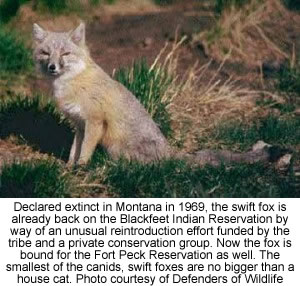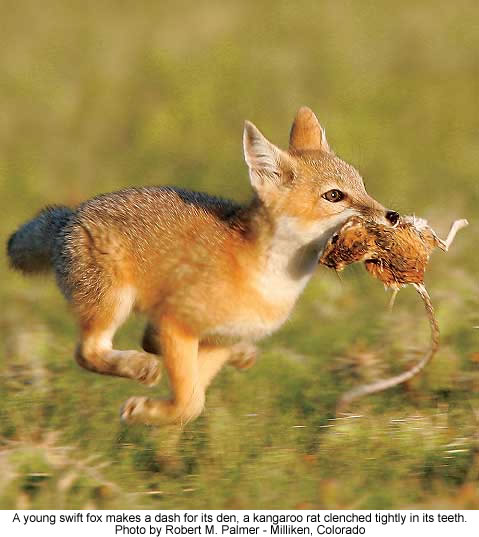 |
Canku Ota
|
 |
|
(Many Paths)
|
||
|
An Online Newsletter
Celebrating Native America
|
||
|
September 1, 2009 -
Volume 7 Number 9
|
||
|
|
||
|
Swift Fox To Be Transplanted
To Fort Peck Reservation
|
||
|
by Brett French of the
Billings (MT) Gazette
|
||
|
The translocation of as many as 30 of the small canines, an equal number of males and females, will help boost the small population that now resides in the vicinity of Little Porcupine Creek, north of Frazer. Ten swift foxes were moved to the reservation in 2006; nine or so occupy the area now. "The tribes have funding to restore native species, and it will assist us in expanding this species of concern farther eastward," said Ryan Rauscher, a native species biologist for Fish, Wildlife and Parks in Glasgow. Funding comes from a $247,000, three-year grant from the U.S. Fish and Wildlife Service. The tribes are contributing in-kind services. "It's thanks to these tribes that we have the swift fox population growing in this state," said Jonathan Procter of Defenders of Wildlife. "The tribes have really been the leaders in the restoration of swift foxes across the Northern Plains." Small
predators Once ranging across the Great Plains, the animals were nearly exterminated. They were killed by poison that ranchers intended for wolves and coyotes. Farmers tilled up native prairies where they lived. Prey, including prairie dogs, ground squirrels and rabbits, were reduced during settlement of the Plains states. And the foxes were caught in traps meant for other animals. "Swift fox were pretty abundant in the days of Lewis and Clark and thereafter," Rauscher said. "But quite a while ago (1969) they were declared extirpated in Montana." The Bureau of Land Management lists the fox as a sensitive species. Montana now lists them as a species of concern because the animals don't occupy all the habitat that they could. Trappers must release any swift foxes they catch that are still alive or immediately report any dead foxes found in traps.
Populations
rebound The U.S. Fish and Wildlife Service determined in 1995 that the animal was threatened, but did not list it as an endangered species because of a lack of information on the foxes' numbers and location. By 2001, enough information had been collected by state wildlife agencies to warrant the swift foxes' removal from endangered species candidacy. It's now estimated that the swift fox inhabits only 40 percent of its former range, which once went from southern Canada to the Texas Panhandle and from northwest Montana to western Minnesota. Canada still lists the animals as an endangered species. Montana officials conservatively estimate the population at 500. The main places the foxes are found are along the Hi-Line in north-central Montana and from the Blackfoot Indian Reservation south along the Rocky Mountain Front. Many of the Hi-Line foxes moved south from Alberta and Saskatchewan to large tracts of undisturbed federal land. Extensive transplants of captive-raised swift foxes re-established the animals on the Blackfoot Reservation. Swift
transplants "Our goal is to be that little, small link between Canada, South Dakota and Wyoming," said Leonard Bighorn, a wildlife technician for the Assiniboine and Sioux tribes. "The Crow and Northern Cheyenne tribes are talking about trying to do this work also, which would be awesome to establish this corridor and fill in this loop that used to go from Canada to Texas." In the past, foxes that were transplanted came from Kansas and Nebraska. If the work in September goes well, Rauscher said it might be the first step in Montana providing swift foxes to other states. The foxes - preferably young ones since they have less fidelity to their home range - will be captured in live traps from areas such as Theony, Whitewater and Chinook. Until all 30 or so have been trapped, they'll be kept in pens near their release site, Bighorn said. The foxes will then be turned loose, all within a quarter-mile or less. In the five years that he has worked with swift foxes, Bighorn has developed an appreciation for the small canines. He said that their diet of ground squirrels, mice and grasshoppers helps keep the tribes' rangelands healthier, meaning the land is more valuable to ranchers who lease it for grazing. That means money for the tribe. "I just think they're an awesome animal," he said. "It's a thrill in the springtime to see them and see how they've reproduced." To learn more about the Swift Fox (Vulpes Velox): |
|
insert map here
|
|
|
||
|
|
||
| Canku Ota is a free Newsletter celebrating Native America, its traditions and accomplishments . We do not provide subscriber or visitor names to anyone. Some articles presented in Canku Ota may contain copyright material. We have received appropriate permissions for republishing any articles. Material appearing here is distributed without profit or monetary gain to those who have expressed an interest. This is in accordance with Title 17 U.S.C. Section 107. | ||
|
Canku Ota is a copyright ©
2000, 2001, 2002, 2003, 2004, 2005, 2006, 2007, 2008, 2009 of Vicki
Barry and Paul Barry.
|
||
 |
 |
|
|
The "Canku
Ota - A Newsletter Celebrating Native America" web site and
its design is the
|
||
|
Copyright ©
1999, 2000, 2001, 2002, 2003, 2004, 2005,
2006, 2007, 2008, 2009 of Paul
C. Barry.
|
||
|
All Rights Reserved.
|
||
 Beginning
next month, some swift fox in north-central Montana will be hitching
a ride to new accommodations on the Fort Peck Indian Reservation.
Beginning
next month, some swift fox in north-central Montana will be hitching
a ride to new accommodations on the Fort Peck Indian Reservation.